I recently answered a query from an excited soon-to-be EV driver looking to set themselves up with the necessary gear for electric car charging.
The Myth Of The “Ideal” EV Charger
At first blush, it seemed like a question I would ask myself. When I go shopping it’s often a case of why are these fully featured things so damned expensive; or why don’t they make this item, with these specific functions, at all?
The missive read like this:
“Brilliant work with the role solar quotes provides. I have been referring to it a lot over the years. You have a great gang of writers who knows their subject and provide sound advice.
As I anticipate the arrival of my model 3, I’m trying to get a charging solution. What I realised would be a good mobile solution is a mobile charger that can plug into 240V, but with a removable type 2 cable that can be just a type 2-type 2 cable for use at public chargers without a cable. Is there such a mobile charger on the market?
The Fronius Wattpilot Go ticks the boxes, as well as being a smart charger for 3 phase home supplies, but adding that to a type 2-type 2 cable comes in at $2200. Whereas, the Tesla mobile charger, a separate type 2 cable and the wall charger comes in at $1600.
Even though I have a fronius 3 phase inverter and fronius smart meter, the economics don’t make sense for the Watt Pilot.
The details in the Tesla manuals are a bit vague but I gather I can only program 1 schedule into the wall charger/ car app, the example in the manual says overnight scheduling for off peak power. Ideally, and what the Watt pilot can do is charge with surplus solar from my PV. But the $/kWh savings are unlikely to bridge the purchase cost of the Watt pilot. I’m just mentioning this is case you or your team decide to do another blog on EV charging.
Ideally a mobile charger with removable type 2 cable would be the best option to carry in the boot. I just can’t find one on the market.”
Thanks for the compliment; we’re always chuffed that people find value in what we do. However, many of us often get lost in the labyrinth of options, comparing features, weighing options and stressing over prices.
My Dad always said, when he bought the most industrial tool he could afford (instead of the handyman version): it’s not about saving a few bucks today; it’s about spending wisely for the future.
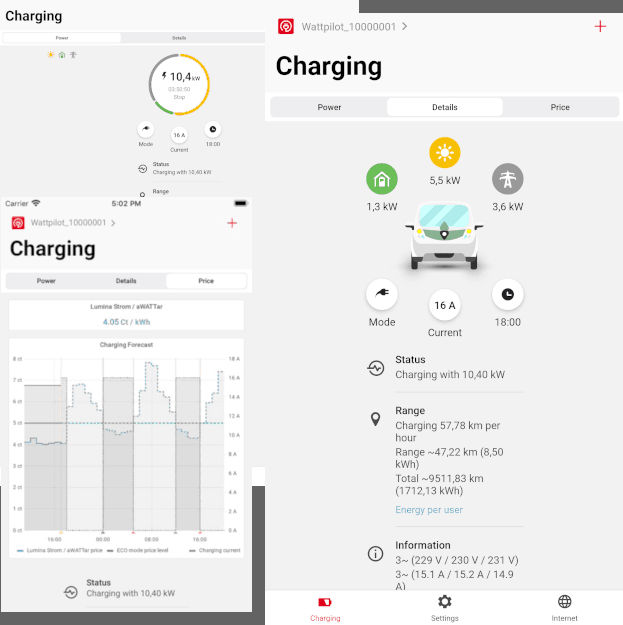
Rich in detail, the Fronius Wattpilot electric car charging app can control for solar energy harvesting or time of use for best pricing.
What Misses the Mark
I’m talking about tools because as an electrician I’m stuffed without them. I have a dozen cordless machines that are all rendered useless if I break the charger, or leave it on the last job site 100km away. So I bought a radio that also charges batteries, for redundancy. You want a decent quality lead and it has to be reliable.
So we’re looking for an EV charger that can plug into 240V, offers a removable type 2 cable, and ideally, provides smart charging features. Let’s address the elephant in the room: it should be cheap.
Having scoured a few sites like Jetcharge, EVSE.com.au and evchargers.com.au for homework — charger price comparison, compatibility, smart features, and so forth, it’s boiled down to the Fronius Wattpilot Go versus the Tesla Mobile Charger. The latter is cheaper and dumber, so I’ll argue buying that is somewhat short-sighted. Here’s why:
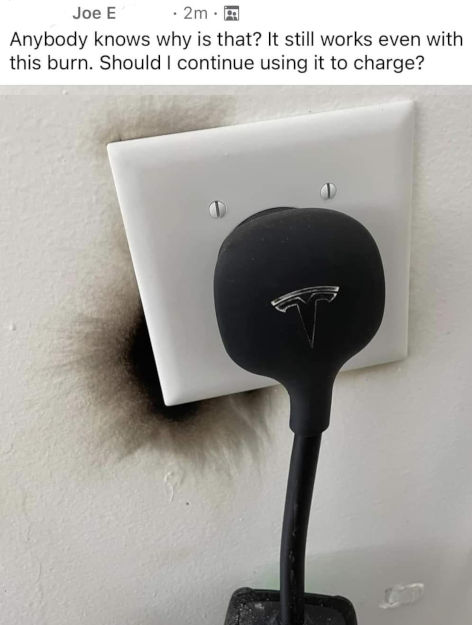
This is a US spec 220v wall plug, and NO you should not keep using it Joe.
Redundancy Is Reliability
SolarQuotes founder Finn has gone through two EV charging cables in three years. Having a backup is not just a luxury—it’s a necessity. Imagine one cable gets pinched, or the car isn’t charging, and you need to quickly diagnose if it’s the cable at fault. With a spare cable in the boot, you can diagnose a faulty cable immediately and also prove to the vendor that you need a warranty replacement.
In terms of smarts, solar surplus charging is great on general principal, even if it seems to be a long payback. And I wouldn’t advise anyone to buy a charger that doesn’t have OCPP communications for reasons we have spelled out previously.
Fronius Make A Great Integrated EV Charging Package
You’re about to own a not-so-cheap electric car. If you already own a Fronius inverter for your solar installation then you’re well into this ecosystem, which has an award-winning EV charger and a unified monitoring platform. Getting a Fronius Wattpilot Go isn’t just another expense—it’s an investment in a seamless charging experience.
It doesn’t have to be Fronius, but having a compatible system just makes more sense than disparate parts cobbled together.
My recommendation (depending on your garage setup) is to have a long EV charging cable at home to reach beyond your normal parking space and a spare in the car, to ensure you’re never caught out. It saves you time winding up a cable every day, the stress of forgetting it, and potentially money in the long run.
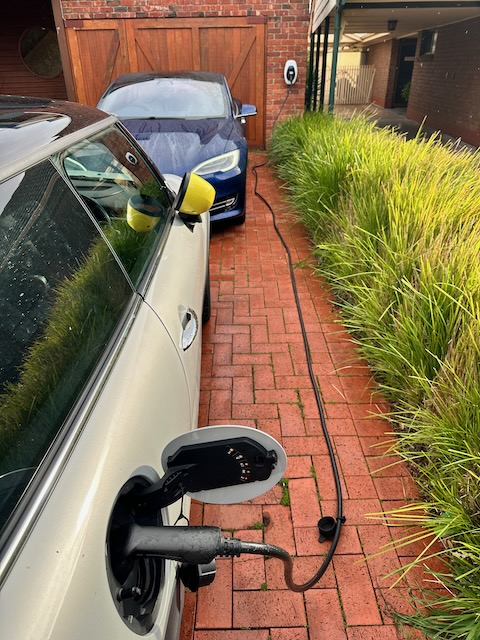
This driveway needs a 10m cable to charge the mini when it is second home.
Your Electric Car Is Useless With a Flat Battery
So, the economics might not seem to favor the Wattpilot when pitted against the Tesla EV charger. But you’ve already invested heavily in both a Fronius solar system and a rooly noice electric vehicle. The Wattpilot isn’t just another charger—it’s the link that unifies your whole home energy system.
Trying to save a few hundred dollars today could leave you stranded tomorrow. Or worse, it might require you to spend more than you “saved” on emergency towing. In the grand scheme of things, paying a premium for a product that offers both reliability and compatibility with your existing setup seems like a no-brainer.
Let’s not forget that the Wattpilot offers the option to charge with surplus electricity from your solar power system —something the Tesla unit can’t do. While the dollar per kWh savings may seem minimal now, consider the long-term gains. With Time-of-Use rates proliferating and dynamic network control changes mooted, having a smart charger could be more economical than you think.
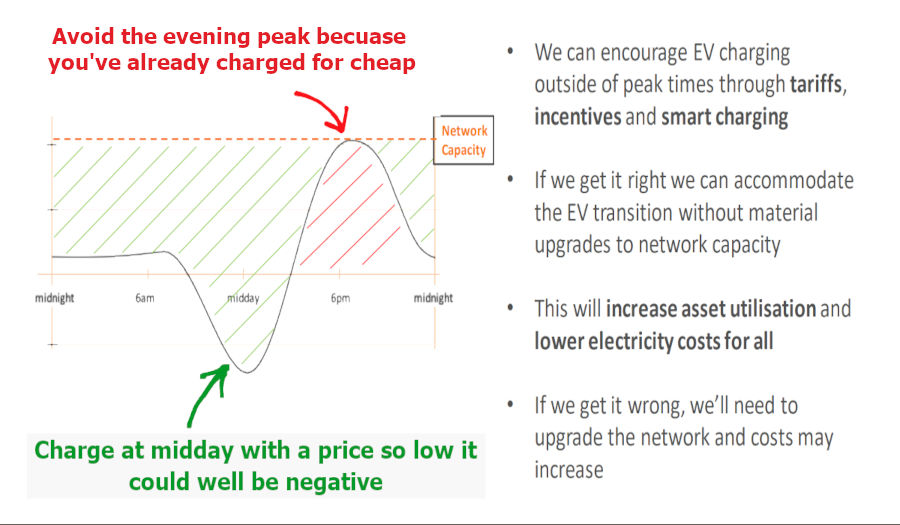
Daily grid demand is what drives electricity price when you have a TOU retail account, besides which the networks will likely want to curtail demand during the evening peak.
So, For My Money…
If you’re revving up to welcome your new EV, remember: quality and reliability shouldn’t take a backseat to cost-saving measures. You’ve already invested in cutting-edge technology, so why cut corners to keep it all running?
While there’s no one-size-fits-all answer, look beyond just the price tags and features, because at the end of the day, an electric car is only as good as its charger.

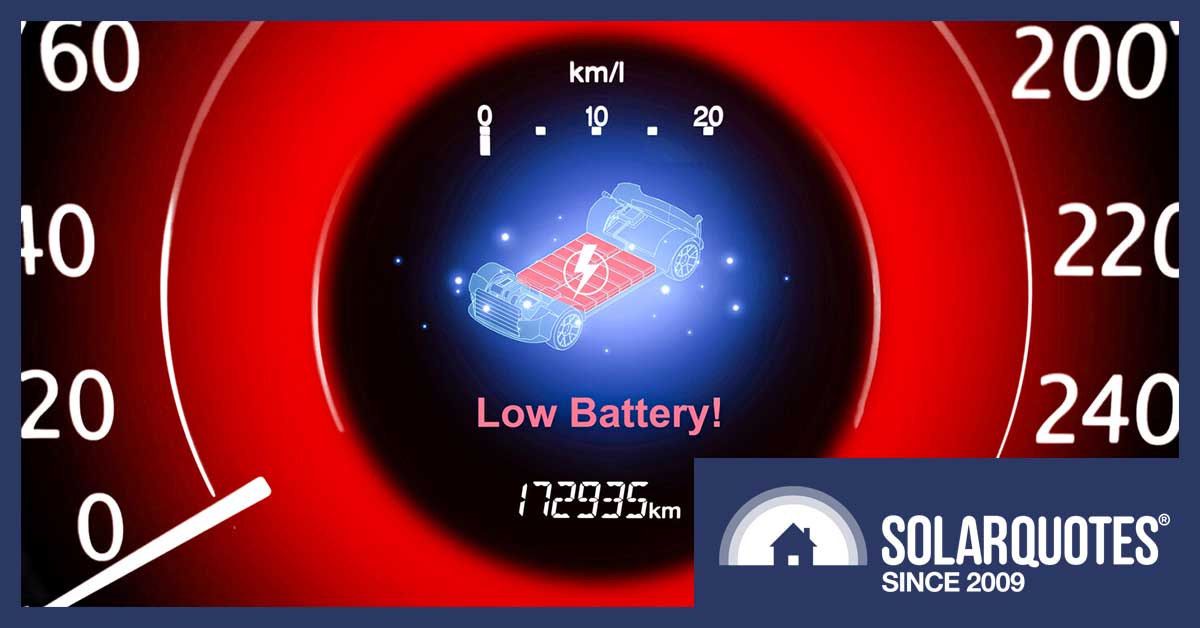
 RSS - Posts
RSS - Posts



Yikes. That photo. I must admit as a non-technical noob apartment dweller I am a bit wary. Even though I will only need to trickle charge from an existing normal electrical outlet already metered to us in our garage, there may be no plan B for home charging if that doesn’t work out.
While trickle charging is often portrayed as just plugging in to any socket, I also read various things about whether a normal socket needs to be on a dedicated circuit, can handle the draw, etc and the MG salesperson I recently asked had no idea that was even a thing. I’d certainly invest in a superior connection to the outlet if that’s a key factor.
If you search solarquotes using “home charging” you will find a couple of blog articles on the subject of trickle charging safely. You are right to be cautious.
Hi Anthony
I’m considering a MG4 Essence. I have 10Kw on my roof. In 3 different strings with 2 Solis inverters and 1 Solax. I’m told MG can supply a charger but am not sure of the cost. How do I know what chargers are able to connect with my solar for recharging?
These guys understand that investing in good EV chargers is a smart move looking forward: https://www.abc.net.au/news/2023-09-25/act-apartment-building-accommodates-electric-vehicle-charging/102895078
I agree with the article. EV ownership will change the demand on the grid & if EV owners do not respect the needs of the grid, the grid owners will likely introduce draconian measures to curb grid peak demand.
The idea of a removable cable on your portable charger is a good one. However, if your car will accept 3 Phase charging (& not all do), get a 3 phase cable. The disadvantage is that the cable is heavier, so harder for the gentler folks to manage. Personally, I use a 10A portable charger & I have a correctly rated 2.5 sq mm extension lead & 10A>15A adaptor. This setup is good in an emergency, but one needs to ensure the cable is laid out flat with no loops & the plugs checked for overheating (at least every 30 mins until you are sure all is OK). This setup is not used very often, but if I go to a friends place in outback Qld, it is needed. I have a spare cable as well.
Units & shared accommodation: my 2c worth! If an EV owner lives in an owned unit, it would be worth getting a seat on the Body Corporate. Non-EV owners are unlikely to consider any form of EV charging unless the idea is presented as a positive step. There are many ways charging can be accommodated: private charging wired to the parking space owners switchboard (which can be difficult & expensive) or shared charging that is owned by the body corporate, but managed by a separate entity that supplies the billing & management services, then charges the cost back to the (EV) users. The difficulty there is managing timeslots for EV access, & the loss of a few parking spaces. Townhouse owners with personal solar are likely to have better access to EV charging than unit owners. btw, EV charging for units is a good chance to install Solar PV because the generation can increase the payback to the body corporate.
I use Charge HQ to read the inverter and control the charge to the EV using only home made solar. The support page here lists smart chargers that may be suitable https://chargehq.net/ev-charger-support-register.
If you use the app to manage the charging, it is a monthly fee. If you find one of the smart chargers can manage the charge from your solar, you won’t need the app.
See also this blog post which notes that the ChargeHQ app/service allows Tesla owners to enjoy smart solar charging with the Wall Connector (subscription required): https://www.solarquotes.com.au/blog/tesla-wall-connector/
I have been using the Tesla wall charger with charge HQ (I have a Tesla battery, not sure if it matters or not), but it works perfectly to track charging via solar – cloudy days arenlt perfect but close, otherwise my charge has been 90% via solar…. And fuss free ….
I understand Tesla can now do the automatics to charge on solar if you have a Tesla and a Tesla battery, without needing ChargeHQ.
As far as I know this is available in the US – I haven’t noticed any software change here in Australia which makes this feature available – but hopefully it’s coming.
I was in a similar situation. Single phase Fronius Gen24 with Solar.Web real time monitoring and a Tesla MY due in August. I needed the EV supply equipment (EVSE) on my general supply circuit so was limited to 20A by QLD wiring rules. Only getting an extra 10A over using a level 1 charger limited how much I was prepared to spend.
I compared the Tesla wall connector + Charge HQ to many other options including the WattPilot. The Tesla wall connector + Charge HQ beat everything else I looked at in terms of the features that I need today at a lower cost.
I went with the Tesla wall connector + Charge HQ. Charge HQ does a really good job of tracking excess solar generation and adjusting charging in real time. In August I charged a total of 343kWh, 236kWh (69%) from solar, 65kWh (19%) from the grid and 42kWh (12%) from free chargers. All at a cost of about $47. All I have to do is plug the car in when it’s parked in the garage. Charge HQ manages everything else.
The end game for EVSE is likely to include bi-directional charging. Anyone installing today will likely have to upgrade at some stage in the future. I’m happy that I haven’t over spent on technology that is still in it’s infancy.
I also had this decision, though slightly more complex as I have a Fronius and a Selectronic inverter. I chose the Tesla charger and am very happy I did.
Simply put either ChargeHQ or a bit of tinkering with Home assistant will allow you to charge a Tesla on solar only. The latter has the advantage that you are not giving the (electronic) keys to your Tesla to anyone else and there is no fee. But you do have to self host a small computer (Raspberry Pi).
If you go down the latter path there are lots of comments on line about how to do this, but basically run TeslaMate and Tesla integration within Home assistant, and you can automate the whole thing.
Hi,
Just got a Volvo EV about 6 weeks ago.
I have two properties, one (main home) with the feed-in tariff of 44c plus whatever the supplier put on-top. I have an older Fronius 5kW system here with no smarts. The other (Holiday home) has the newer 10kW Gen24 Fronius system with only 7c feed-in tariff. I have bought a WattPilot Go “charger” with a plate installed at both locations. I have no plans to use solar power in the first property to charge my EV but installed the charging system incase I need to charge the EV. I will use the grid power if necessary.
I have been charging the EV at the second property in the weekends only using the solar function on the charger. Takes 1.5 days to charge to 90% and I get about 460km. We use about 250km during the week. The second property is 60km away.
So far, I have not had to pay for charging the EV (free fuel). There will be circumstances where I will have to pay for charging, but I feel I will be able to minimise this. The WattPilot maybe abit more expensive but in the long run, it will pay itself off with the feed-in control I get.
We have a 2012 year 3.04 kw (16 Suntech x 190w) panel and a SMA TL3000 single phase inverter and plan an EV later this year. Type unsure at present. I am installing 6mm cables from sw/bd to garage, and am unsure of what type and how many control cables needed for CT’s etc. and where they should be routed, and as to what brand and model of charger to fit. We will be adding another perhaps 5kw of panels and possibly a Fronius inverter (battery ready). What should I be planning with please. TIA. … Bill..
We recently purchased an EV and we are fortunate to have 3-phase power to our house, so instead of a dedicated EV charger, we installed a standard separate circuit 3-phase outlet in the driveway.
We use an EVSE portable 22kw charger / cable: https://evse.com.au/product/kwik-portable-type-2-22kw-charger-with-5-pin-australian-plug/
It was more cost effective and more versatile than a dedicated EV charger.
And…it pains me to say, we don’t have a solar system to charge our home or EV either, because when we factored in the cost of installation of a solar system, it negated the so-called ‘free fuel’ for the EV for 12 years! (…when we factored in the home electricity usage and charging the EV – which currently only costs us around $20 per ’tank’ per week).
Even if we also factored in the $100 fuel cost savings compared to our old ICE car travelling the same distance, and instead put that money towards weekly repayments on a solar system, we would only break-even over a minimum of 5 years. …Solar is therefore not ‘free power’ for at least 5 years and more likely longer (if you need to replace components / system at end of warranty / paying it off).
Arguably, solar trickle charging is not really a viable EV home charging option anyway. Our 3-phase mains charger charges the EV to 90% charge at 11kw in 4 hours, instead of effectively 2 days sunlight.
…So instead of solar, we are on the lowest tariff available and we are effectively putting the pressure back onto the NSW government to transition to renewable power. (NB: If we lived in the ACT or Tasmania we would already be on 100% renewable power) ..and we’re very happy to purchase any solar power over-load from the grid.
As a small household that uses relatively small amounts of power, we would love to be on solar! And perhaps in 5 years when bi-directional EV’s are the norm and can be used as a home battery, when solar efficiency rises and costs come down, we will reconsider home solar.
My partner recently took delivery of a BYD Dolphin. We have had a Wallbox Pulsar Max charger installed in the garage and I have been experimenting with optimum charging to take advantage of excess solar PV.
For now I am manually monitoring the Tesla Powerwall app to check for a large grid export. I then use the Wallbox app to start charging the Dolphin. The key point I want to make is that the app allows me to set the maximum current draw for charging. In this way I can match the car charging with the excess solar that would otherwise go to the grid.
I consider this current limiting ability an important feature for EV chargers.
BTW the electrician installed the Wallbox upstream (or is that downstream) of the Powerwall donut (forgot the technical term!) and so the Powerwall does not try to charge the car.
BTBTW I may eventually start a ChargeHQ subscription to automate the optimal charging. However, we generally have low weekly km and so I am happy to continue doing this manually.
I’m charging my Tesla M3 with the Tesla wall charge and using Home Assistant to manage the Solar/Eco charging, tracks it very well. I looked at the Fronius charger, just too expensive, even more so when you include installation.
For those on 3-phase power (and solar with a compatible inverter looking to utilize their PV surplus) isn’t the automatic phase-switching of the Wattpilot a big deal? If I understand it correctly, that means that when your excess solar gets below 4.14kW (across the 3 phases), it will switch to 1-phase charging and is able to utilise excess solar down to 1.38kW. Does that mean that it can cobble together whatever excess solar there is across the 3 phases and turn it into 1-phase charging all the way down to (a combined) 1.38kW? If it doesn’t, then won’t it often just cut out when excess solar gets below 4.14kW because on average you will only have 1.38kW on any single phase at that time? Isn’t the main issue with cheaper 3-phase chargers, that they need 1.38kW of PV surplus across all 3 phases to charge (or pull in power from the grid for the phases that are under)? And the issue with 1-phase chargers is they can only be wired up to a single phase so will only be able to access, on average, 1/3 of your excess solar?
When I look at the net loads across our 3 phases (including any PV surplus) there are often 1 or 2 phases with under 1.38kW of excess solar (or even importing from the grid), even though the system is exporting greater than 1.38kW across the other phase (or two). Am I right in assuming that the Wattpilot, as distinct to other chargers, is clever enough to utilize that PV being exported? Or am I overstating the Wattpilot’s capabilities (or understating the capabilities of other chargers)?